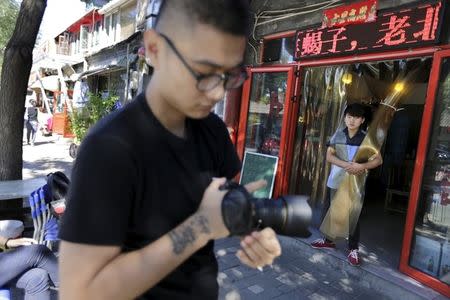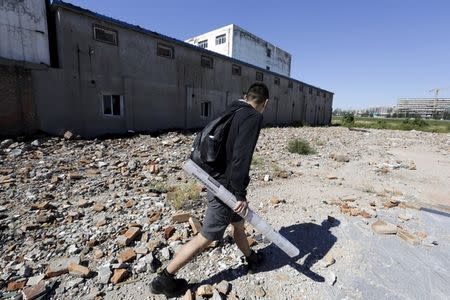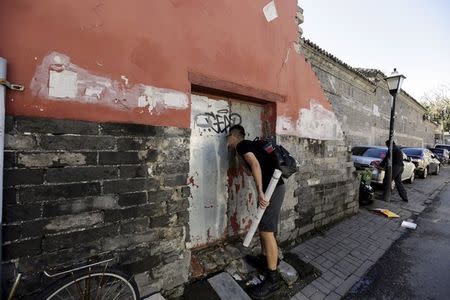Beijing's abandoned buildings: canvas for a rare street artist
BEIJING (Reuters) - A 25-year-old artist in Beijing who calls himself ROBBBB has found a unique canvas for his work, one he hopes helps capture the fast-paced changes in China's capital: the walls of abandoned and half-demolished buildings. On crumbling edifices down back alleys or by construction sites he has glued enlarged images of photographs of people from around the city, sometimes striking unlikely poses. One well-worn wall depicts a man in a suit kneeling and holding out a glowing flower among piles of debris. Another series is made up of huge images of smiling faces stuck to broken walls around the city that, like many in China, is dotted with demolition and construction sites. Other images show legs that appear to stick up out of the ground. ROBBBB - who declined to be identified by his real name - said his work is a comment on the development of Beijing, home to more than 20 million people and the capital of the world's second-largest economy. "After the '08 Olympics, Beijing developed more and more rapidly. Tall buildings and towers rose from the ground, producing more urban ruins. I believe that these ruins are the intersection of the city's development," he said. "They're actually just like street art - they all contain some sort of temporary quality. I hope that years later, people will see my art and think of Beijing of that time." China is home to a coterie of contemporary painters whose works fetch millions of dollars at auction, but street artists are rare. For ROBBBB, it doesn't matter if the public understands his work. "What's more important is to reflect my own inner thoughts with this art, as well as my reflections on this society that I live in," he said. To date, ROBBBB said he has put up nearly 200 pieces across Beijing. Many people are bemused. "This sort of form of art is pretty uncommon in China. I've read more about these forms of art in the news, or magazines from other countries," said a 60-year-old man who surnamed Sun. Others welcomed the images. "There is something special about this street art," said university student Li Xiabing, peering at an image of an older woman carrying groceries on a wall near Beijing's famed drum tower. "When I just walked by, I thought that this auntie really looked like a real person, and there is something three-dimensional about the vegetables," Li said, referring to the woman's shopping. "It appears pretty life-like." ROBBBB said his name came from his English name, Rob. The second 'b' stands for Beijing, the third for Blek le Rat, a stencil graffiti artist in Paris, and the fourth for "best", to encourage himself to work hard. (This story corrects Beijing's population in the fourth paragraph, amends media slug to conform) (Reporting by Joseph Campbell; Writing by John Ruwitch; Editing by Robert Birsel)



